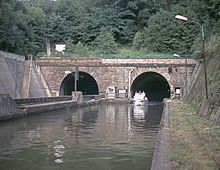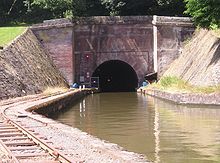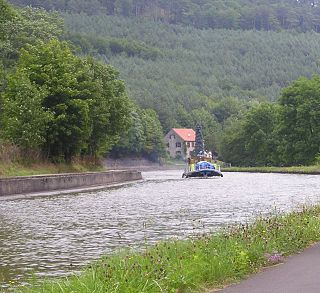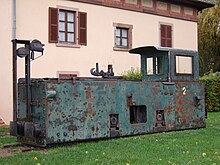Canal de la Marne au Rhin
| Canal de la Marne au Rhin | |
|---|---|
|
Canal de la Marne au Rhin between Saverne and Lutzelbourg |
|
| Water code | FR : ---- 0092 |
| location | France , Grand Est region |
| length | 293 km |
| Built | 1839-1853 |
| class | I ( Freycinet class ) |
| Beginning | Crossing from the Canal latéral à la Marne at Vitry-le-François |
| The End | It flows into the Rhine in the north of Strasbourg |
| Descent structures | 154 |
| Ports | Bar-le-Duc , Toul , Nancy , Strasbourg |
| Junctions, crossings | Canal entre Champagne et Bourgogne , branch canal to Houdelaincourt , Canal de la Meuse , canalized Moselle , Saarkanal , canalized Ill |
| Used river | Saulx , Ornain , Maas , Mosel , Meurthe , Sânon , Zorn , Ill |
| Outstanding structures | Mauvages tunnel, Saint-Louis / Arzviller boat lift |
| Kilometrage | Towards the Rhine |
| Line from Toul to Frouard out of order - will be bypassed over the Moselle! | |
| course | |
The Canal de la Marne au Rhin ( German Rhine-Marne Canal ) is a shipping canal in northeast France that runs in the Grand Est region .
course
The canal connects the Canal latéral à la Marne ( German Marne side canal) and the Canal entre Champagne et Bourgogne (German: Canal between Champagne and Burgundy) in Vitry-le-François with the Moselle near Nancy and the Rhine near Strasbourg . In its course it crosses two watersheds :
- Mauvages- summit level between Marne and Moselle and the
- Vosges apex posture between Meurthe and Rhine.
Connection to other channels
- Branch canal to Houdelaincourt ,
- the Canal de la Meuse (formerly: Canal de l'Est , branche Nord) branches off at Troussey ,
- east of Nancy the Canal de jonction de Nancy leads to the Canal des Vosges (German: Vogesen Canal, formerly: Canal de l'Est, branche Sud),
- The Canal des Houillères de la Sarre (German: Saarkanal ) branches off near Gondrexange ,
- in Strasbourg it comes together with the old northern section of the Canal du Rhône au Rhin (German: Rhine-Rhone Canal).
Coordinates
- Starting point of the canal: 48 ° 43 ′ 48 ″ N , 4 ° 36 ′ 29 ″ E
- End point of the canal: 48 ° 35 ′ 38 " N , 7 ° 48 ′ 13" E
Crossed departments
Places on the canal
- Vitry-le-François
- Bar-le-Duc
- Ligny-en-Barrois
- Toul
- Frouard
- Nancy
- Hesse
- Saverne
- Hochfelden
- Strasbourg
technical infrastructure



The type of canal is a double watershed canal . Today it is 293 kilometers long and has a total of 154 locks , which have been expanded for ships of the standard size Freycinet . It consists of the following sections:
- Western section from Vitry-le-François to Toul with 97 locks. In Mauvages - summit level of the channel reaches a height of 281 meters. This section includes the 4,880 meter long Mauvages Tunnel , through which boats and ships are pulled by two steam-powered chain tugs from 1887 and by an electric chain tug since 1912. Another tunnel on this section is the Foug Tunnel , with a length of 866 meters.
- The original middle section of the canal between Toul and Frouard was closed and replaced by the canalised Moselle . This section is no longer officially part of the canal.
- Eastern section from Frouard to Strasbourg with 57 locks. With the Vosges apex, the canal overcomes a height of 267 meters and has two tunnels 480 and 2,310 meters in length at Niderviller and Arzviller . Today ships can drive through these with their own power (one-way regulation). From 1930 to 1977 were towing there first electric tractors and later a Treidelbahn with electric locomotives in use. The ascent to the apex position is via the Écluse de Réchicourt-le-Château lock , shortly after the Arzviller tunnel, the Saint-Louis / Arzviller boat lift leads back down into the valley of the Zorn .
Lower gate of the Écluse de Réchicourt-le-Château lock - the towing rail tracks ended on the top and bottom right
history

The Canal de la Marne au Rhin was completed in 1853, until 1979 it was the longest canal in France with 315 kilometers. In that year, as part of the expansion of the Moselle, the canal section in the Moselle valley (between Toul and Frouard) was closed and replaced by the canalised Moselle. Since then, the navigable canal is only 293 kilometers long.
In the years 1964-1969 the building was inclined hydraulic lift Saint-Louis / Arzviller the lock staircase Arzviller abbreviated seventeen locks. The Écluse de Réchicourt-le-Château lock, built between 1960 and 1965 , which is the highest French lock in a Freycinet canal with a height difference of up to 16.10 meters , replaced another lock staircase with six locks.
Economical meaning
Today, due to the large number of locks on the canal and their small dimensions, freight transport is no longer important. However, the waterway is used intensively for water tourism with sport boats and houseboats . Pleasure boat rental companies have set up shop along the canal.
The towpath on the canal has been developed into a busy cycle path in Alsace (Bas-Rhin department) from the Vosges to Strasbourg.
The great basin in Saverne with the Rohan castle
Combined canal and railway bridge over the Meurthe
Towing railway
To 1930 was on the canal with horses, increasingly electrically from then on towed . In a transitional period, there was partly mixed operation of the two types of towage. While rail-bound towing railways were built west of Nancy , the ships from there to Niderviller were pulled by tractors powered by overhead lines. It was not until the 1950s that these were replaced by towing locomotives running on tracks . On the section in the industrial area to the east of Nancy came tugboats used.
The towing railway in the western section was operated by the Compagnie Générale de Traction sur les Voies Navigables (CGTVN) and had a gauge of 1000 mm , the railway in the eastern section between Niderviller and Strasbourg was operated by the Traction de l'Est (TE) with a gauge of 600 mm. For this purpose, the TE-Bahn had ten two-axle locomotives with one end driver's cab, the draw hook for the rope was on the flat front end. The locomotives were usually on the move in pairs and each moved a tow of a maximum of five 350-tonne ships. In the middle of the route, the towing ropes and towing units were swapped between the locomotives, which then continued in the opposite direction.
After the new lock at Réchicourt-le-Château went into operation in 1964 , the tow railway was interrupted there. The tracks on both levels ended from then on at the western wall. In 1970 the towage business was given up.
Others
On November 14, 2015, a TGV test train derailed at Eckwersheim near Strasbourg on a bridge on the new LGV Est européenne railway line across the canal. A powered end crashed into the canal bed, the accident claimed several lives.
literature
- A. Hess: The Rhine-Marne Canal. In: Allgemeine Bauzeitung , year 1871, XXXVI. Volume, pp 80-104, 137 -174 (Text); 13 -20 (plans). (Online at ANNO ). .
- Henri Rebsamen: Shipping on the Marne-Rhine Canal . In: Otto Schlaginhaufen et al. (Red.): Communications from the Geographical-Ethnographic Society Zurich . Volume XXXI., Year 1930-1931, ISSN 1013-8846 , pp. 21-42. - digitized .
Web links
- Information on the channel in the Babel project (French)
- River tourism between Arzviller and Strasbourg PDF document in German, English and French
Individual evidence
- ↑ a b The information on the canal length is based on the information on the Canal de la Marne au Rhin at SANDRE (French), accessed on December 1, 2011, rounded to full kilometers.
- ↑ Oskar Teubert: The inland navigation - A manual for everyone involved. Volume 2, Verlag Wilhelm Engelmann, Leipzig 1918, Part 4, Section III., Ship Train. 4. Dragging on a chain or rope, pp. 268–287.
- ↑ Le tunnel de Mauvages at nordest.vnf.fr, accessed on March 7, 2019
- ↑ a b Gérard Bianchi: Les Cahiers du Musée de la Batellerie. La traction mécanique sur berge en France . Association des amis du Musée de la Batellerie, Conflans-Sainte-Honorine 2015, ISBN 2-909044-69-6 , p. 43 .
- ^ Cycle paths (Voies vertes) in France
- ↑ Pierre Miquel: Histoire des canaux, fleuves et rivières de France at Google Books, accessed on March 7, 2019
- ↑ Gérard Bianchi: Les Cahiers du Musée de la Batellerie. La traction mécanique sur berge en France , p. 48.
- ↑ Rolf Löttgers: Europe's last Treidelbahn . In: railway magazine . No. 6 , 2017, ISSN 0342-1902 , p. 46-49 .
- ↑ Traction mécanique sur les voies navigables dans les années 50 at papidema.fr, accessed on February 25, 2019
- ^ Un TGV d'essai déraille près de Strasbourg, au moins 10 morts at lemonde.fr, 14 November 2015
- ↑ Accident de la rame d'essai de TGV: 10 morts, douze blessés graves, cinq personnes recherchées at dna.fr, November 14, 2015











